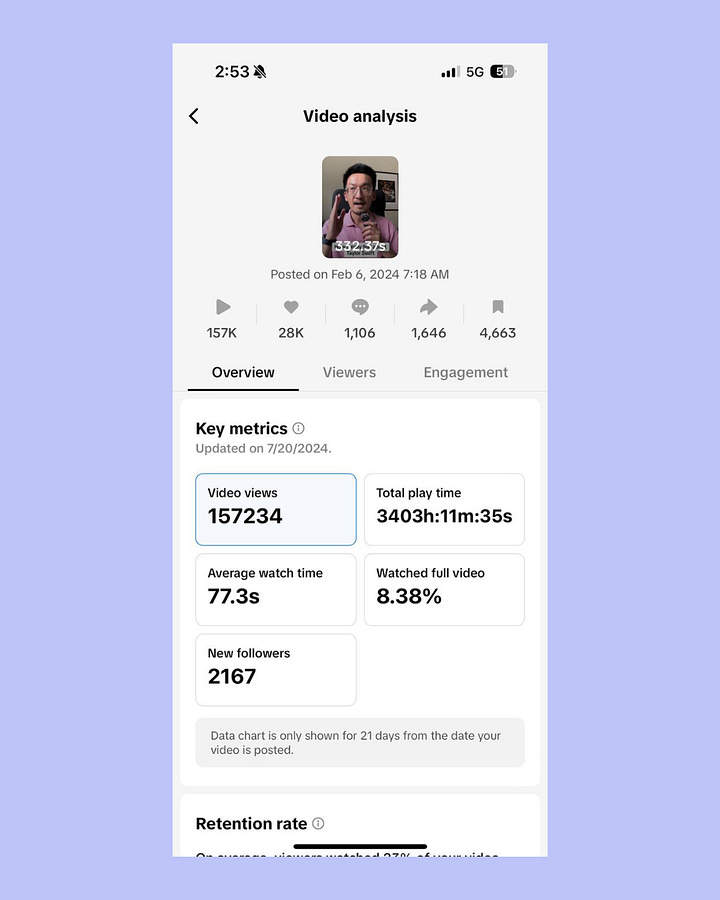How TikTok keeps you addicted - by removing friction
TikTok and the Product Stickiness-Friction Correlation Theory
How TikTok keeps you addicted - by removing friction
It can be argued that TikTok is one of the most addicting apps. From Statista:
In 2023, users worldwide spent approximately 34 hours using TikTok per month. Users in the United Kingdom spent more than 49 hours on average using the popular social video and live streaming app, while users in the United States spent 45 hours and 37 minutes monthly on the app.
In this article, I’ll demonstrate how TikTok has achieved increased product stickiness by reducing friction for users. For more examples of this concept, check out my article on the Product Stickiness-Friction Correlation Theory.
Specifically, I’ll be examining how TikTok has decreased the friction to:
binge watch videos
create videos
share videos
remix videos
analyse videos
Decreased the friction to binge watch videos
From my article Product Stickiness-Friction Correlation Theory
Prior to TikTok, YouTube dominated the video-watching landscape, but there was friction when it came to binge watching videos. While YouTube did introduce features that increased product stickiness, such as What to Watch Next Module and Auto-play, the friction still remained. Additionally, videos were served from subscribed channels, leading to a potential shortage of new content.
TikTok took the radical approach of offering an endless stream of videos, optimised through machine learning to maximise watch time. All users had to do was either:
A) continue watching the video or
B) swipe up for the next one
This eliminated any friction to binge watch videos and ensured users were glued to their app.
TikTok’s successful approach has been copied by both Instagram and YouTube.
Decreased the friction to create videos
Before TikTok, creating a video was an arduous task. You either had to be proficient in software like Final Cut Pro, which had a significant learning curve, or resort to Windows Movie Maker, often producing mediocre results. Both options required a desktop or laptop.
TikTok’s native video editing suite is incredibly intuitive, mobile-first, and surprisingly powerful. For example, manually adding subtitles to a video usually takes around five times the video's length, but TikTok can complete it in a matter of seconds with a single button. From my personal experience, the subtitles are roughly 90% accurate and only require a few minor tweaks.
Another example is TikTok’s green screen feature. Traditionally, using a green screen requires a physical screen and some technical know-how. On TikTok, creators can simply record themselves with a digital green screen at the touch of a few buttons — see below.

For content creators looking to level up even further, they can switch to CapCut, which is owned by TikTok’s parent company, Bytedance. The app offers a wide array of features, including several AI-powered ones such as text-to-image generation, AI translation, and one-click long video to shorts splicing. Notably, CapCut has released both PC and Mac apps, signalling their expansion ambitions.
Decreased the friction to share videos
Most social media companies limit the ability to share content to other channels to maximise the time users spend on their own platform. TikTok, on the other hand, has purposely decreased the friction to sharing videos.
Let’s take a look at TikTok’s sharing features — see below.
Not only does TikTok list every social media channel for users to share to, but it also includes options for Email, SMS, QR Code, and a Repost button. Additionally, there’s a row of suggested TikTok users to DM.
However, I should point out that TikTok has started to change its sharing policy, now redirecting users without the app to download it in order to view the shared video. This increase in friction has actually led me to share fewer videos with friends who don't have the app, causing me to spend less time on TikTok and more on Instagram.
While this forceful tactic may help increase app downloads in the short run, in the long run, it may end up frustrating users who prefer to stick with their incumbent apps, such as Instagram.
Decreased the friction to remix videos
Remixing videos and participating in viral trends have been crucial to TikTok’s explosive growth. TikTok has lowered the barrier to participating in a trend through a myriad of ways including:
Templates: Pre-made video templates that simplify content creation.
Duet Feature: Allows users to post their video side-by-side with another creator's video.
Stitch Feature: Enables users to incorporate a part of another creator’s video into their own.
'Use This Sound' Feature: Lets creators easily use viral sounds or music in their videos — see below.
Decreased the friction to analyse videos
Savvy content creators know the importance of analysing their videos to demystify the algorithms of each social media channel. However, most channels don’t make this task easy. TikTok decreases this friction by providing a comprehensive suite of analytic tools, helping creators level up their understanding of digital analytics.
For each video, TikTok provides the following metrics:
Overview - views, avg. watch time, total play time, traffic sources, search queries
Retention rate - complete with an interactive graph that helps you pinpoint when users stopped watching
Viewer demographics - new/returning, gender, country, age
Engagement - most common words in comments, when viewers liked




The sheer depth and breadth of data that TikTok provides is incredible, if not alarming, enabling creators to easily analyse their videos. TikTok’s lead in analytics is even more apparent when compared to what Instagram Reels offers — see below.
I hope you enjoyed reading this article on 'How TikTok Keeps You Addicted.' If you did, please share it with a friend. And if you haven’t already, check out my article on the Product Stickiness-Friction Correlation Theory.
Things that caught my attention
Lofi Girl - this is my default playlist I listen to while writing all of my articles








